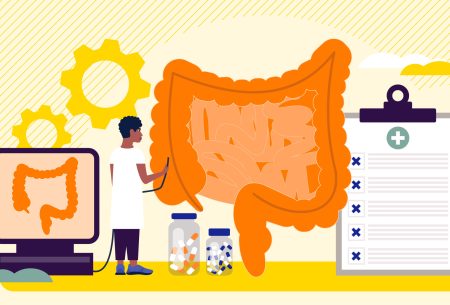The goal of Pancreatic enzyme replacement therapy (aka PERT) is to mimic part of the normal function of the pancreas which is a key component of our digestive system. PERT involves taking medication that provides enzymes to enable the digestion of fats, proteins and carbohydrates. So, to digest all the food we eat.
Each PERT capsule contains:
- Lipase – to break down fats (this is what we measure PERT doses with)
- Protease – to break down proteins
- Amylase – to break down carbohydrates (sugars)
- When is PERT needed?
The majority of people will never need PERT, however, there are some common circumstances in which they are helpful. These broadly fall into two categories:
- Pancreatic exocrine insufficiency (PEI) is when there is an issue with the pancreas itself. If your pancreas does not produce or release enough digestive enzymes then malabsorption of foods occurs. This is common with the following conditions:
- pancreatic cancer
- full or partial removal of the pancreas
- acute and chronic pancreatitis (link to previous blog post)
- cystic fibrosis
It is also sometimes seen in other conditions such as diabetes mellitus, coeliac disease and Crohn’s disease.
- Secondary insufficiency is when enough enzymes are released but not in sync with food and so the issue of malabsorption is still present. This can occur following surgery to the gastrointestinal tract including weight loss surgery.
Diagnosis of PEI
PEI can be diagnosed by a medical professional (such as a doctor, oncologist, gastroenterologist or dietitian) based upon clinical presentation and response to enzymes. Tests to look at the structure of the pancreas include scans or X-rays, but these may miss less severe cases.
Often a stool sample called faecal elastase is used as a diagnostic tool that measures enzymes within your stool to provide an estimate of how many are being produced by your pancreas. Note that this stool sample is not always a reliable indicator of PEI as it may not pick up mild or moderate PEI. False-positive and negative results are seen in practice. The faecal elastase will also not account for a secondary deficiency which is why in practice often PERT are prescribed without the stool test to see whether symptoms improve.
Often medications to reduce acid levels, called PPIs, are prescribed alongside PERT to help improve the function of these enzymes, which are less effective in an acidic environment. Commonly a medication called loperamide (Imodium) is also prescribed which will help slow gut motility if loose stools are an issue.
Correct dosing of PERT
One of the biggest challenges we see with PERT is incorrect dosing.
At each meal, the pancreas is thought to produce around 720,000 units of the enzyme lipase which is used to digest our fats. It’s thought that our body uses around 10% of this (the rest is excreted through our stools). Hence the often standard starting dose of 75,000 units of lipase with each meal (capsules often come in denominations of 25,000). However, for many people, this starting dose will not have a significant positive impact on their symptoms. Often, the doses need to be doubled, or alternative preparations considered.
The doses also need to be tailored to the meal that is in front of you. Eg. a dish of pasta in a tomato sauce has less fat and less protein than a dish of pasta with cheese sauce. Therefore, more enzymes to digest the additional fat and protein are required with the cheesy dish.
If you are prescribed PERT, you should be advised of your dosing by a dietitian who specialises in the area. We have dietitians here at The Gut Health Clinic who can provide this advice and liaise with your GP to ensure the appropriate prescription amount is provided according to your needs.
Note that over-the-counter enzymes are not strong enough to manage PEI or secondary malabsorption. If you suspect it, check with your GP or gastroenterologist who can prescribe high strength enzymes if needed!
Correct timing of PERT
Another key element is correct timing. PERT must be taken with meals and the dose is often best split evenly throughout the meal. The reason is that once swallowed, these enzymes will only be active for around 20 minutes. Some individuals do benefit from taking the majority of the enzyme capsules towards the beginning or the end of the meal. This is something that is often tailored with a dietitian if symptoms of malabsorption are ongoing and other strategies aren’t working.
PERT is also required with some snacks and drinks and this dose should be varied depending on the size and composition of your food/drinks.
Consequences of untreated PEI: monitoring your dose of PERT
It is key to monitor your symptoms and adjust your dose of PERT to ensure you’re not maldigesting/malabsorbing your food.
Symptoms of malabsorption to look out for include:
- Loose, oily, smelly and/or floating stools that are difficult to flush (aka steatorrhoea)
- Stools that are paler than normal – they could be pale brown, yellow, orange, grey, or event white (note that some medications mask this symptom)
- Abdominal discomfort or pain
- Abdominal gurgling noises
- Reflux and/or heartburn
- Increased symptoms following a fatty meal
- Weight loss
These can all be signs that your dose is not high enough. You can malabsorb up to 50g of fat without any visible symptoms. This is the equivalent of 450kcals/day, which could equate to almost 1lb (0.5kg) of weight loss per week! Note that often steatorrhea is a late-stage symptom. It’s important to not just consider the stools when thinking about PERT and PEI.
If left untreated, or only partially managed it can also lead to vitamin deficiencies, malnutrition, reduced bone mineral density, cardiovascular events, and reduced life expectancy. It really is crucial therefore to get the support you need if you have been diagnosed with, or suspect PEI.
Conclusion
PERT can be tricky to manage and is often under-prescribed. Input is needed by a specialist dietitian to ensure you’re absorbing your food adequately and optimising your nutritional status. You can ask your GP or gastroenterologist to refer you to a dietitian, or do please get in touch with us directly.
As a side note – November is Pancreatic Cancer Awareness Month. Therefore, please make sure you, your family, and your friends know the symptoms of pancreatic cancer. Also, please see your GP if you’re experiencing any of them.
This blog was authored by Lucy Kerrison, a gut specialist dietitian.














